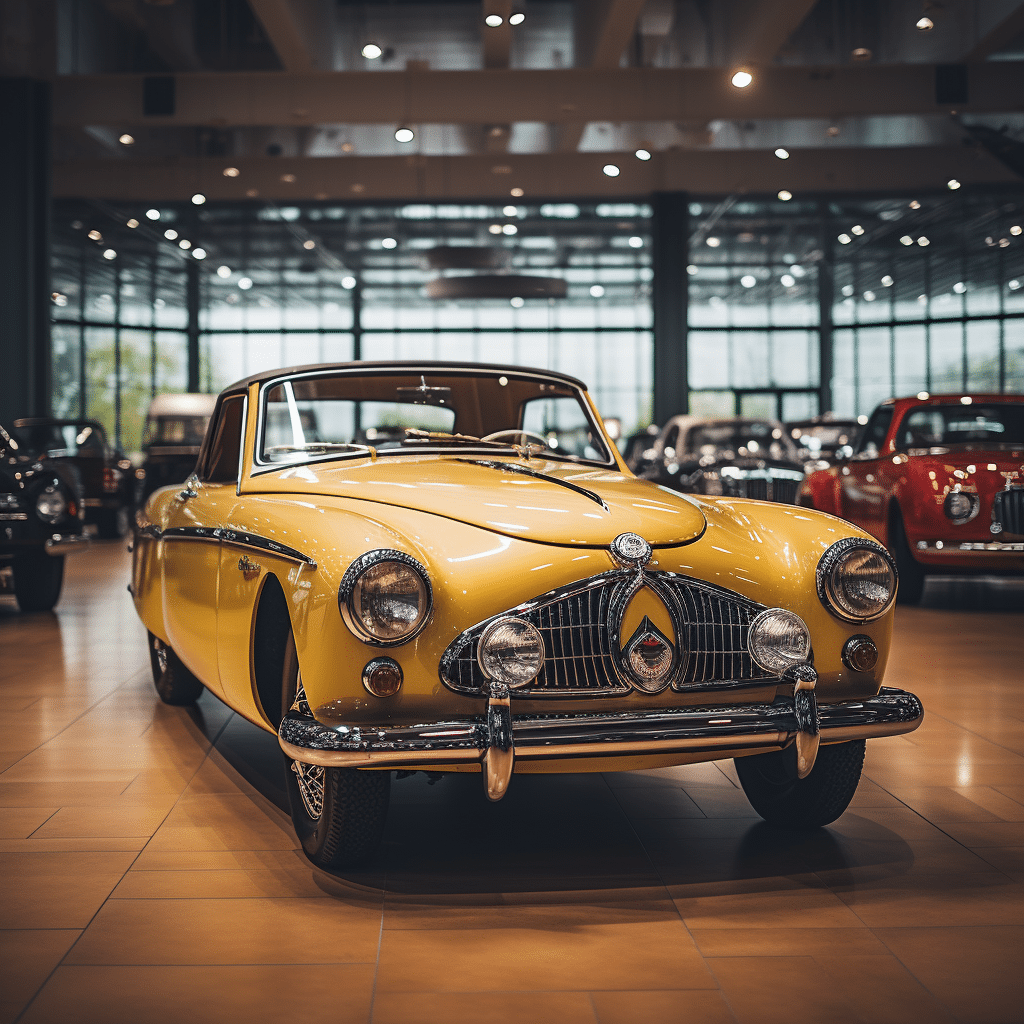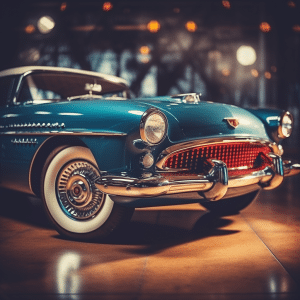
Mastering Classic Car Buying: Tips and Steps for a Wise Purchase
When buying a classic car, there are various factors to think about. Examining it carefully is key to guarantee you get a great deal. Here, we will go through the steps for inspecting a classic car and offer you tips and advice.
- Start by examining the exterior. Look for rust, dents, or scratches, which could show poor maintenance or accidents. Focus on the body panels, doors, and fenders as they can be costly to repair. Check the paint job too as it can increase the value of the car.
- Move to the interior. Analyze the upholstery, dashboard, and steering wheel for tears or cracks. Make sure all buttons and switches work. Inspect the carpeting and headliner too, as replacing them is expensive.
- Examine the engine bay. Check for leaks, loose wires or hoses, and excessive wear or corrosion. Know the components under the hood and make sure they are clean and in good condition.
- Don’t forget to take the car for a test drive. This will give you an idea of its performance on different roads. Notice any unusual sounds, vibrations, or handling problems.
Inspecting a classic car needs knowledge and attention to detail. If you are not sure of your skills, or would like an expert opinion, ask assistance from a qualified mechanic or car specialist. They can give you useful insights and help you make the right decision.
Researching the Classic Car Market

Research is key when you’re buying a classic car. Find out about trends, prices, and availability. Do this and you can make a wise decision and find the perfect classic car for you. Here are a few aspects to consider:
- Classic Car Models: Learn about the various models and their features. Know what makes each model special.
- Rarity and Popularity: Check the rarity and popularity of a car model. Rare models have high prices.
- Condition: Look at the car’s condition. See if there are any damages or signs of wear. Have a mechanic check it too.
- Market Value: Research sales data to know the current market value. Compare prices from online auctions, classified ads, and dealerships.
- Ownership History: Check the car’s ownership history. Get maintenance records, previous owners’ information, and refurbishments.
Do your research and you’ll be able to choose the right classic car. But trust your judgment too!
Setting a Budget
When it comes to buying a classic car, setting a budget is essential. It helps you know your financial limit and prioritize what you can afford. Here’s what to consider:
- Check your finances: Look at your income, expenses, and savings to know how much you should spend.
- Look at the market: Study prices of classic cars like yours to set a realistic budget.
- Factor in extra costs: Think about insurance, maintenance, and potential restoration work.
- Prioritize your preferences: Decide what features are most important and focus your budget accordingly.
- Plan for unexpected costs: Account for unforeseen expenses during inspection or after buying the car.
When setting your budget, remember that classic cars tend to hold or increase in value. You can begin your journey with confidence, knowing that every dollar spent is worth it.
Classic Cars Magazine says 70% of classic car buyers spend more than originally planned due to restoration costs.
Determining Your Needs and Preferences
It’s key to know what you need and prefer in a classic car before buying one. Think about your budget, desired model, features, and personal taste for the perfect match. Here’s a breakdown:
| Aspect | Description |
|---|---|
| Budget | Analyze your financial limits. |
| Model | Select a classic car model. |
| Features | Choose the vehicle features. |
| Taste | Consider your individual style. |
To cover more details, take into account practicality, maintenance costs, and rarity of certain models. This will help you decide based on your needs.
Fun Fact: During the mid-20th century, classic cars were symbols of luxury. Demand for vintage vehicles increased as people collected rare models. This made it even more important to consider one’s needs and preferences when getting a classic car.
Carefully assess your desires, budget, and practicality when figuring out what you need from a classic car. This will lead you to the perfect choice that matches both your heart and mind.
Hiring a Professional Inspector
A professional inspector is the key to acquiring a classic car. Expertise and experience, combined with an objective assessment of the car’s condition and value, can make all the difference. They conduct a thorough inspection, covering all essential components and providing a detailed report with estimated repair costs. Hiring an expert can bring peace of mind, avoiding unexpected expenses and regrets.
Make sure the inspector specializes in classic cars for accurate evaluations. Michael Duncan’s story is a reminder – the inspector saved him from buying a lemon. Stewart Holmes’ expertise and attention to detail revealed hidden faults beneath the car’s paint job. A professional inspector can be the deciding factor between joy and regret.
Inspecting the Exterior of the Classic Car
The exterior of a classic car is essential when it comes to inspecting before making a purchase. By looking at it carefully, you can determine its quality and any potential issues that may appear in the future. Here are some things to keep in mind:
- Paint: Look closely for any signs of cracking, peeling, or fading. Also, see if there are any inconsistencies in color and texture that could indicate repairs or refinishing.
- Rust: Check the body panels, wheel wells, and undercarriage for rust and corrosion. Pay special attention to places prone to rust – such as around the windows, door sills, and wheel arches.
- Body Panels: See if there are any dents, scratches, or misalignments on the body panels. These may show past collisions or bad repairs.
- Chrome Trim: Look at the chrome trim pieces, including bumpers, grilles, and window surrounds. Check for pitting, flaking, or discoloration that may call for costly restoration.
- Glass: Examine all windows for cracks or chips. Make sure they roll up and down without any hassle.
- Lights: Check if all headlights, taillights, turn signals, and brake lights are functioning correctly.
Also, don’t forget to consider the smaller details that may have been missed during a quick look. This includes inspecting the condition of external accessories like mirrors, emblems, and badges.
It’s notable that classic cars with original paint usually gather more interest from collectors. According to Hagerty Insurance Agency’s data analysis in 2020, well-maintained vintage cars with their factory finishes often sell for higher prices due to their authenticity and historical value.
Beware that assessing the exterior condition is just part of evaluating a classic car thoroughly. Don’t forget to take a look at other aspects like the engine, interior, and documentation to make a well-informed buying decision.
Inspecting the Interior of the Classic Car
Inspecting the interior of a classic car is key before buying. Its condition reveals important info on its history, maintenance, and worth. Here’s a 3-step guide:
- Check the Upholstery: Look for signs of wear, rips, or discoloration. Faded or uneven coloring may reveal previous repairs or neglect. Smell for water damage or mold.
- Inspect the Instrument Panel: Check the ignition. Ensure all gauges and indicators work properly. Test buttons, knobs, and levers.
- See Storage Spaces: Check glove compartments, consoles, and trunks for rust or water damage. Test locks, latches, and hinges.
While inspecting, pay attention to rare features like special upholstery or custom mods which could affect value.
True Story: In 1969, a classic Camaro Z28 was found in a barn. Despite its state, it was one of 20 with a rare houndstooth interior. After careful restoration, it became valuable due to its originality and unique interior.
Examining the Engine and Under the Hood
The engine is the heart of a classic car and it’s essential to inspect it well before buying. Here are some key areas to look at:
- Fluid Levels – Check the oil, coolant, and brake fluid levels for proper upkeep.
- Leaks – Watch out for any signs of leaks, such as oil or coolant stains.
- Belts and Hoses – Check the belts for wear and tension, and the hoses for cracks or leaks.
- Battery – Check the condition and connections of the battery.
- Air Filter – Make sure the air filter is not clogged with debris.
- Electrical System – Test all lights, horn, wipers, and other electrical components.
- Keep an ear out for any unusual noises or vibrations during your inspection. If needed, ask a professional mechanic to give it a full check.
When buying a classic car, it’s important to examine its history. Ask the seller for maintenance records or receipts that prove regular servicing. This suggests good care over the years.
These steps will help you make a more informed decision before investing in a timeless automotive treasure. Knowledge is power in such cases!
Test Driving the Classic Car
Performance: Take a classic car for a spin to see its power, acceleration and braking. Listen carefully for any strange noises or vibrations.
Condition: Check the wheels’ alignment and the steering smoothness. See if the suspension has any damage or wear.
Handling: Test how the classic car does on roads and curves – observe its responsiveness and stability.
Plus, be sure to feel comfy in the vehicle. Is there enough legroom? Do the seats give you enough support? These are important too!
Edmunds.com says it best: “Test driving a classic car helps you know its character before buying.”
Verifying the Vehicle History and Documentation
Want to make a wise decision when buying a classic car? It’s crucial to check its vehicle history and documents. This means taking a look at the Vehicle Identification Number (VIN), registration papers, maintenance records, and any accidents or repairs. Here’s what you should consider:
- Vehicle Identification Number (VIN): Make sure the VIN on the paperwork matches the one displayed on the car. This confirms its authenticity.
- Registration Papers: Check these to ensure they are up-to-date and no discrepancies exist in terms of ownership or title status.
- Maintenance Records: Reviewing them helps you tell if regular servicing has been done, meaning a well-maintained car.
- Accidents or Repairs: See if there are any reports of accidents or major repairs to assess the condition and potential future issues.
Don’t forget other details unique to classic cars. For instance, check if all original parts are still intact and if any modifications have been made. With classic cars, parts can be hard to find. So, thorough inspection is key.
Let me share a story. A friend once bought a classic car without checking the documentation. It had outstanding liens, leading to legal and financial woes. This emphasizes the need to inspect the docs carefully.
By following these tips and learning from stories, you can ensure a smoother and more informed buying experience. Remember: verifying the vehicle history and documents is a must for a confident purchase.
Negotiating the Price and Finalizing the Deal

When it comes to buying a classic car, there are some steps you must take. Following these tips can help you get a good deal and avoid any issues.
- Research the market value. Know the model, year, condition, and rarity of the car. This research will help when negotiating.
- Set your budget. Decide what you can afford and stick to it.
- Inspect and assess. Check for any repairs or maintenance that may be needed. Use this as leverage during negotiations.
- Be ready to walk away. Don’t let emotions cloud your judgment.
- Seek professional advice. Consult with an expert or bring someone knowledgeable with you.
- Don’t rush into any decisions. Take your time and use this guide for negotiating. Classic cars keep their value well. Don’t miss out – take action now!
Conclusion
Inspecting classic cars? Essential! Here are some steps to follow:
- Evaluate exterior and interior.
- Check engine, bodywork, upholstery for damage or wear.
- Check VIN numbers and service records.
- Test drive the vehicle to assess performance and handling.
- Consult experts or mechanics for a comprehensive evaluation.
Plus, check for rust or corrosion in areas like the undercarriage and wheel wells. Inspect electrical components, like lights and gauges, to make sure they function. Don’t forget tires and brakes for safety.
Pro Tip: Hire an independent appraiser specializing in classic cars before buying. Their expertise can give you an unbiased assessment of value and condition.
Inspect thoroughly before buying classic cars! Pay attention to common areas and unique details. Confidently navigate the market to find your perfect timeless ride.
Frequently Asked Questions
1. How do I inspect a classic car before buying it?
Inspecting a classic car before buying it involves a thorough examination of various aspects. Start by checking the overall condition, bodywork, frame, and paint for any signs of rust, damage, or repairs. Next, inspect the engine and other mechanical components, including the brakes, suspension, and exhaust system. It is also crucial to assess the interior, upholstery, and electrical systems. A test drive should be performed to evaluate the car’s performance. Additionally, consider hiring a professional mechanic or classic car expert for a comprehensive inspection.
2. What documents should I review during the inspection?
Reviewing the car’s documentation is essential in assessing its history and value. Check for the title, registration, and any records of previous owners. Look for service and maintenance records, receipts for repairs or modifications, and the vehicle history report. These documents provide valuable insight into the car’s maintenance, potential accidents, or past damages that might affect its value and reliability.
3. Are there any specific tools I should bring for the inspection?
While not mandatory, it is advisable to bring some basic tools to aid in the inspection process. These tools may include a flashlight for examining dark or hard-to-reach areas, a magnet to check for possible bondo or hidden body filler, a tire tread depth gauge, and a code reader to scan the car’s computer system for any error codes or issues. These tools can provide additional information about the car’s condition and help you make an informed decision.
4. Should I inspect the classic car in person or can I rely on online listings?
Inspecting the classic car in person is highly recommended. Online listings may not always provide accurate or sufficient information about the car’s true condition. Seeing the car in person allows you to thoroughly examine its physical attributes, test drive it, and detect any potential red flags that might be missed in photographs or descriptions. In-person inspections also give you the opportunity to ask questions directly to the seller or dealer.
5. Is it necessary to hire a professional mechanic for the inspection?
While not mandatory, hiring a professional mechanic or a classic car expert can provide valuable insights and ensure a thorough inspection. They have the expertise to identify hidden issues, evaluate the mechanical components, and assess the overall condition of the classic car. A professional inspection minimizes the risk of purchasing a car with hidden problems and gives you peace of mind about your investment.
6. How much does a professional classic car inspection usually cost?
The cost of a professional classic car inspection can vary depending on factors such as the location, the type of car being inspected, and the level of expertise required. On average, inspections can range from $200 to $500. While it may seem like an additional expense, it is a worthwhile investment considering the potential savings on future repairs or buying a car with hidden issues.
